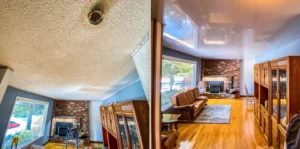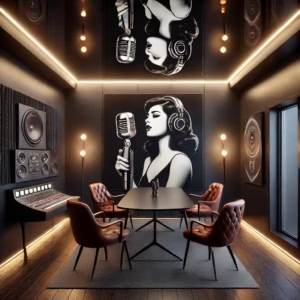At Space Ceiling, we know that creating a home theater room is a dream for many movie enthusiasts and entertainment lovers.
Transforming a space in your house into a cinematic haven can elevate your viewing experience to new heights. With the right planning, equipment, and design, you can bring the magic of the big screen right into your home.
In this guide, we’ll walk you through the essential steps to create your perfect home theater room.
Planning Your Dream Home Theater
Selecting the Ideal Space
The first step in creating a home theater is to choose the right room. Basements often provide the best environment due to their natural darkness and isolation. If a basement isn’t available, consider a spare bedroom or a less-used living area. The key is to select a space that you can easily darken and that’s somewhat separated from high-traffic areas of your home.
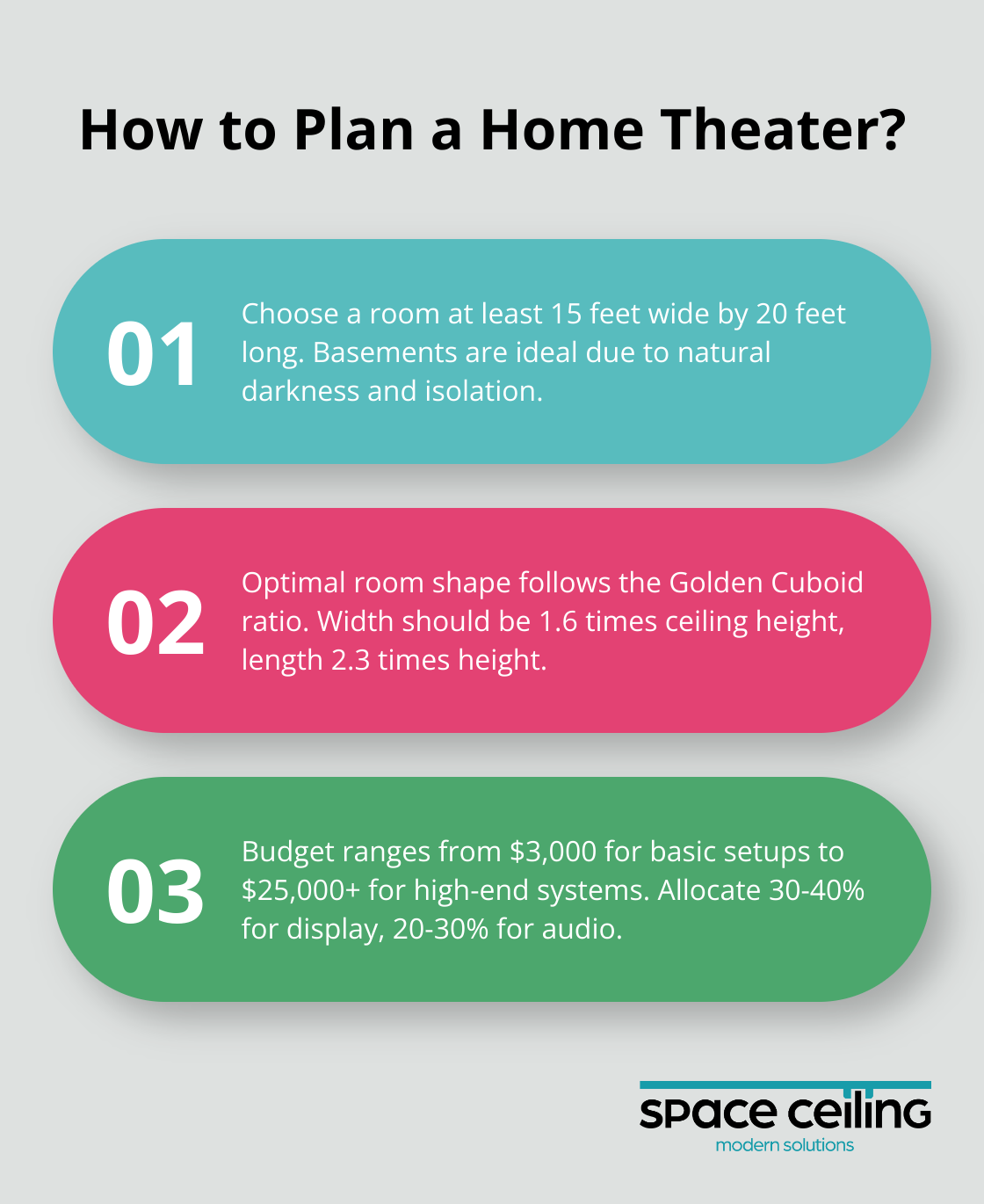
A survey by the Consumer Technology Association reveals insights into home entertainment trends. To join this trend, try to find a room that’s at least 15 feet wide by 20 feet long. This size allows for comfortable seating and proper equipment placement without feeling cramped.
Optimizing Layout for Sound and Sight
The shape of your chosen room significantly impacts sound quality. The Golden Cuboid is considered the best rectangular shape for a listening room. For optimal acoustics, try to select a room with a width that’s 1.6 times the ceiling height and a length that’s 2.3 times the height.
Consider the placement of your screen and seating carefully. The ideal viewing distance is about 1.5 times the diagonal width of your screen. (For example, a 120-inch screen requires about 15 feet of viewing distance.) Plan your seating arrangement accordingly, and if space allows, consider tiered seating for an authentic theater feel.
Setting a Realistic Budget
Home theater budgets can vary widely. A basic setup might cost around $3,000, while high-end systems can exceed $25,000. Break down your budget into these key components:
- Display (TV or projector and screen): 30-40% of total budget
- Audio system: 20-30%
- Seating: 15-20%
- Room treatments (acoustics, lighting): 10-15%
- Miscellaneous (wiring, remote controls): 5-10%
Factor in installation costs if you’re not planning a DIY approach. Professional installation typically adds 10-20% to your total budget but can ensure optimal performance and prevent costly mistakes.
Considering Acoustics and Lighting
The acoustics of your home theater will play a major role in your viewing experience. Consider installing sound-absorbing materials on walls and ceilings to improve sound quality. (Acoustic panels can double as decorative elements, adding both function and style to your space.)
Lighting is another critical factor. Install dimmable lights to create the perfect ambiance for movie watching. Consider adding LED strip lights behind the screen for a subtle glow that reduces eye strain without compromising picture quality.
With these planning steps complete, you’re ready to move on to selecting the essential components that will bring your cinema dreams to life. Let’s explore the key equipment that will transform your space into a true home theater.
Selecting Essential Components for Your Home Theater
The Display: Your Window to Entertainment
The display serves as the centerpiece of any home theater. Your choice between a TV and a projector depends on room size, budget, and viewing preferences. For rooms under 150 square feet, a large 4K TV (65 inches or larger) provides the best balance of picture quality and value. Samsung’s QLED TVs offer exceptional brightness and color, which makes them ideal for rooms with some ambient light.
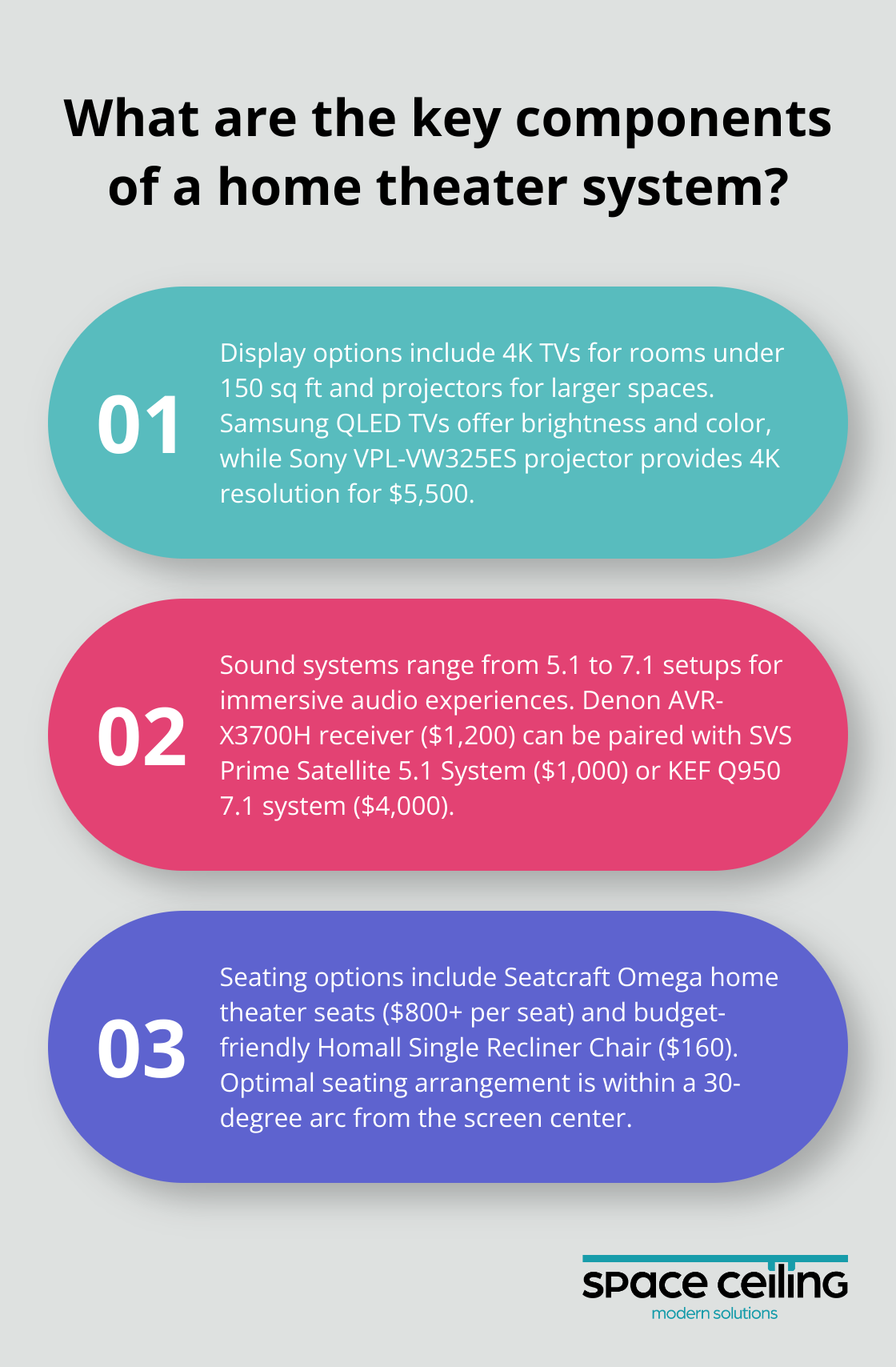
Larger spaces benefit from a projector and screen combo to create a true theater-like experience. The Sony VPL-VW325ES delivers stunning 4K resolution and HDR support (though it comes with a hefty price tag of around $5,500). You can pair it with a 120-inch acoustically transparent screen from Elite Screens (approximately $1,000) for immersive viewing without compromising sound quality.
Sound System: Enveloping Your Senses
A high-quality sound system creates an authentic cinema experience. A good 5.1 system, like the Bowers & Wilkins 606 and 607 S3 speaker package, delivers all the heft you need for a properly immersive home cinema experience.
The Denon AVR-X3700H receiver ($1,200) offers excellent processing power and supports the latest audio formats. You can pair it with a speaker set like the SVS Prime Satellite 5.1 System ($1,000) for rich, room-filling sound. Larger rooms or audiophiles might prefer the KEF Q950 7.1 system ($4,000) for unparalleled audio clarity.
Seating: The Foundation of Comfort
Comfortable seating enhances long movie sessions. Choose chairs or sofas with good lumbar support and reclining capabilities. The Seatcraft Omega home theater seats (starting at $800 per seat) offer a luxurious leather finish, built-in cupholders, and power recline features.
For a more budget-friendly option, the Homall Single Recliner Chair ($160) provides comfort without breaking the bank. Try to arrange seating for optimal viewing angles – typically within a 30-degree arc from the center of the screen.
Smart Control Systems: Streamlining Your Experience
Integrate a smart control system to manage your home theater effortlessly. The Sofabaton U2 Universal Remote Control is the best option under $100. This model has some notable flaws, but compared with its competitors, it offers good value for money.
Media Players: Expanding Your Content Options
A versatile media player expands your entertainment options. The NVIDIA Shield TV Pro ($200) supports 4K HDR playback, gaming, and various streaming services. For those who prefer physical media, the Panasonic DP-UB820 4K Blu-ray player ($500) delivers exceptional picture quality and supports multiple HDR formats.
Now that we’ve covered the essential components, let’s explore how to optimize your room’s acoustics and lighting to create the perfect viewing environment.
Perfecting Your Home Theater Acoustics and Ambiance
Taming Sound Reflections
Sound reflections can muddy dialogue and reduce the impact of your audio system. We recommend you cover about 20% of your room’s surface area with sound-absorbing materials. Acoustic panels provide a great start, but don’t stop there. Install thick curtains on windows and doors to absorb sound and block light. For a budget-friendly option, place bookshelves filled with books strategically to diffuse sound effectively.
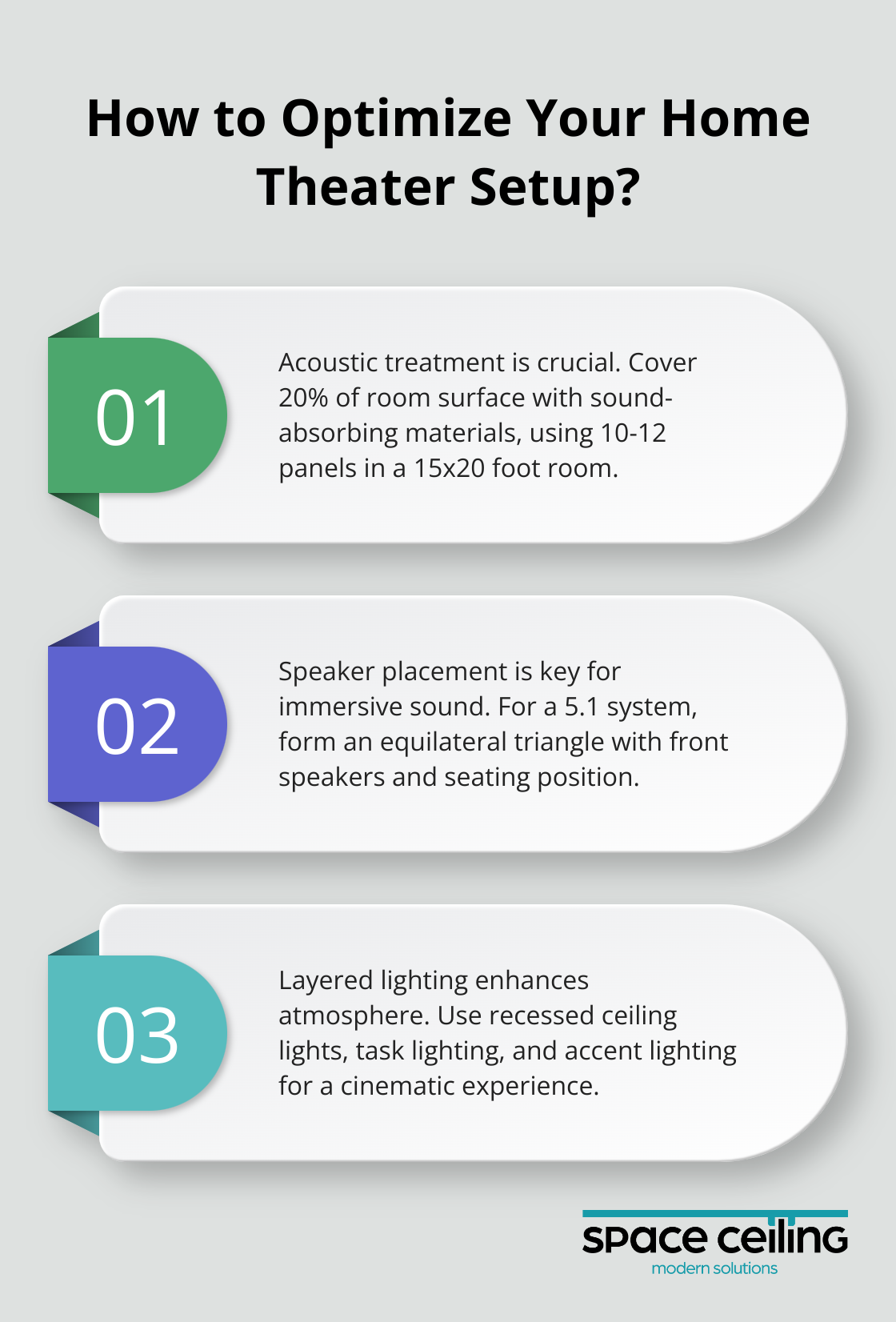
GIK Acoustics offers a range of acoustic panels (starting at around $60 per panel). A 15×20 foot room might need about 10-12 panels to make a noticeable difference. Place these panels at the first reflection points on your side walls and on the back wall behind your seating area for optimal effect.
Speaker Placement for Immersive Sound
Proper speaker placement creates an immersive soundstage. For a typical 5.1 surround sound setup, place your center channel speaker directly below or above your screen. Your front left and right speakers should form an equilateral triangle with your main seating position, angled slightly inward.
Surround speakers work best when placed slightly behind and to the sides of your seating area, about 2 feet above ear level. If you use a 7.1 system, place the additional rear surround speakers directly behind the seating area.
For your subwoofer, try the “subwoofer crawl” technique. Place the subwoofer in your main seating position, then crawl around the room’s perimeter while playing bass-heavy content. The spot where the bass sounds best is where you should permanently place your subwoofer.
Crafting the Perfect Lighting Scheme
Lighting plays a key role in creating the right atmosphere for movie watching. We recommend a layered lighting approach. Start with ambient lighting to provide overall illumination when needed. Recessed ceiling lights on a dimmer switch are ideal for this purpose.
Next, add task lighting for activities like finding snacks or navigating the room. Wall sconces or small table lamps work well for this. Finally, consider accent lighting to highlight room features or create a cozy atmosphere. LED strip lights behind the screen or under seating can add a cinematic touch.
For ultimate control, invest in a smart lighting system like Philips Hue. Their system allows you to control color, brightness, and even sync your lights with your movie for an immersive experience.
The goal is to eliminate any light that could reflect off your screen and wash out the image. Blackout curtains or shades are essential for rooms with windows. The Nicetown Thermal Insulated Blackout Curtains, available on Amazon for about $40 per panel, are an excellent and affordable option.
Enhancing Room Acoustics
To further improve your room’s acoustics, consider adding bass traps in the corners of your room. These specialized acoustic panels absorb low-frequency sound waves, which can often cause problems in home theaters. You can purchase pre-made bass traps or build your own using rigid fiberglass insulation and fabric.
Try to minimize hard, reflective surfaces in your theater room. Replace tile or hardwood floors with carpet or large area rugs. If you have exposed windows, cover them with heavy drapes when watching movies. These steps will help reduce unwanted echoes and improve overall sound quality.
Creating a Cinematic Atmosphere
To complete your home theater transformation, add some cinematic touches to your decor. Install a movie poster light box to showcase your favorite films. Add some theater-style seating with cup holders and reclining features for ultimate comfort. Consider a small popcorn machine or candy display to recreate the full movie theater experience at home.
Final Thoughts
Creating a home theater room combines technology, design, and personal taste to transform your space into a cinematic haven. We explored key steps from room selection to component choices and acoustic optimization. Your home theater should reflect your style and enhance your viewing pleasure, so don’t hesitate to experiment with different elements.
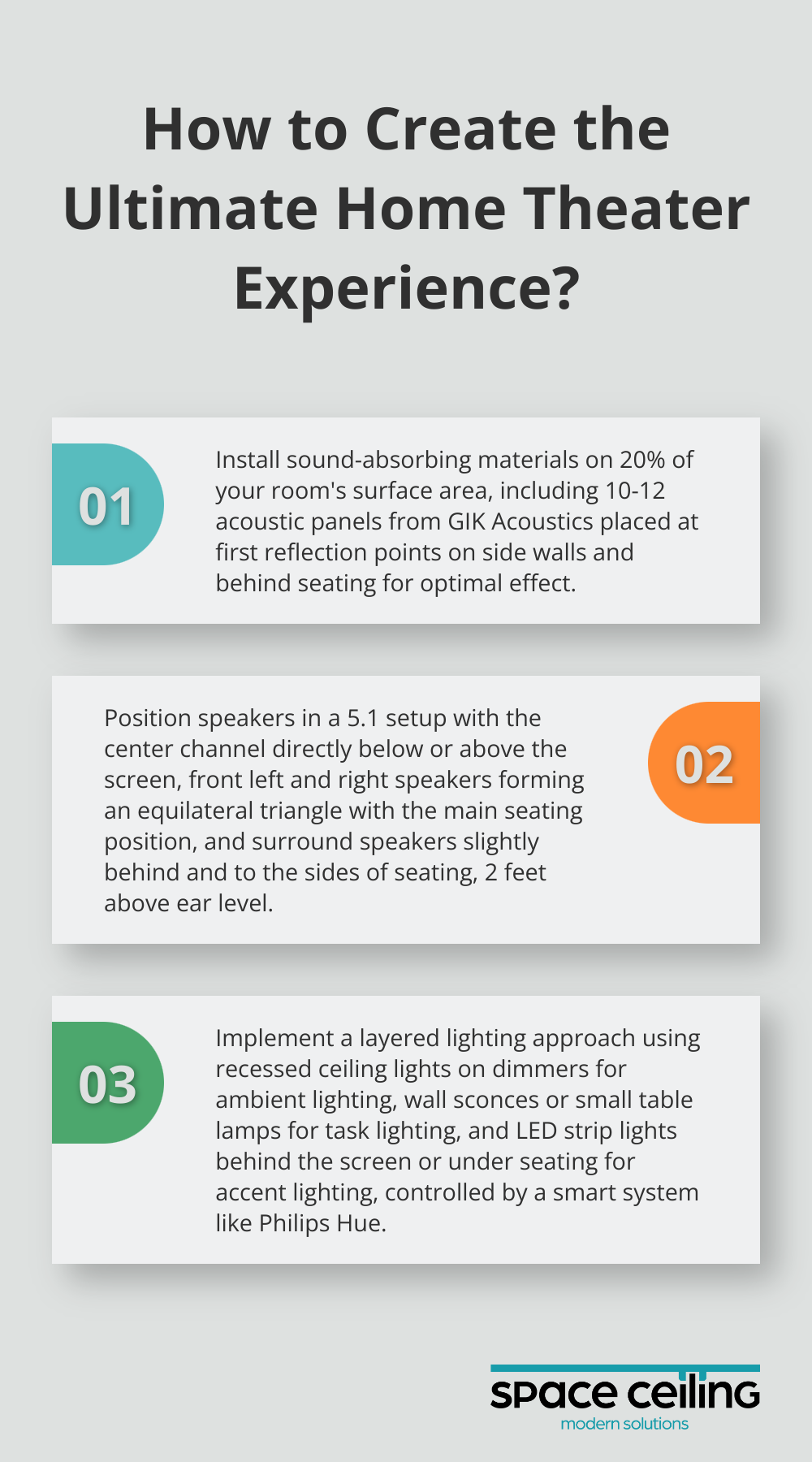
We encourage you to start your home theater project today. The process may seem challenging, but the result will provide countless hours of entertainment for you and your family. With careful planning and attention to detail, you can create a space that impresses guests and becomes your personal escape.
At Space Ceiling, we offer innovative solutions to enhance your home theater room. Our modern stretch ceilings, available in various colors and finishes, can create a seamless, customized look. We even offer stunning star and galaxy ceilings that bring the night sky indoors, adding an extra layer of magic to your viewing experience.
Originally posted on January 18, 2025 @ 3:08 am


